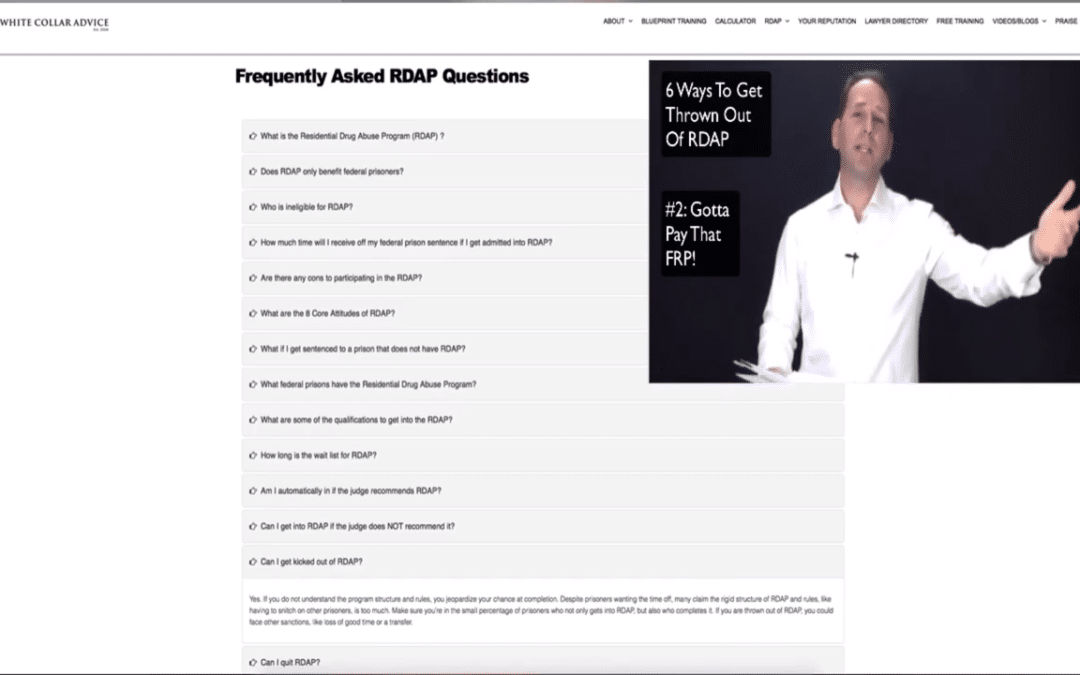Our team has been guiding people through the criminal justice system for a long time. During this time, I have learned a lot of things. Some of these things I have learned are fairly obvious.
What are one of these obvious facts? Bingo, big surprise! Every defendant, including me, wants to know what they can do to get out of federal prison as early as possible.
One of the ways prisoners can leave federal prison early is by completing the Residential Drug Abuse Program (RDAP). To become eligible for early release through RDAP a number of things have to happen, including:
1: The person should be able to document that he/she has a history of substance abuse during the 12-month period that preceded the arrest for the current offense.
2: Minimum sentence of 24 months or more (quick note, we have had some clients do RDAP on sentences of 21 months).
3: The defendant should not have any issues that could result in deportation.
4: The person should not have any history of violence or weapons.
5: The person should not have any serious mental problems.
6: The person must now how to read and write in order to complete the program.
In my case, I did not disclose nor did I have a history of substance abuse or drinking. Even if I did have a problem, and presuming I disclosed it during my probation interview, I would not have qualified for the program because my federal prison sentence was only 18 months.
In practice, the Presentence Investigation Report (PSR) will be the most relevant documentation when it comes to qualifying for the RDAP program. The more evidence a person can provide to show a history of substance abuse, the better.
But in practice, to qualify a person should admit to substance abuse within the 12 months that preceded the arrest. If the person makes such an admission during the interview with the probation officer for the presentence investigation report, that self-reporting may suffice. The more verification, the better.
Program Statement 5330.11 provides some guidance on what psychology staff must consider for RDAP applicants. The staff is supposed to review the PSR to assess whether the applicant meets the diagnostic criteria for abuse or dependence on the Diagnostic and Statistical manual of Mental Disorders, Fifth Edition (DSM-V).
The substance abuse doesn’t have to be linked to the offense, and a judge doesn’t have to recommend RDAP.
“Justin, how long can I get off my prison sentence if I complete RDAP,” I am asked a lot.
The amount of time off depends upon the length of sentence imposed:
• Sentence of 37 months or longer: Receive up to 12 months off the sentence upon the completion of RDAP.
• Sentence of between 31 and 36 months: Receive up to nine months off the sentence upon the completion of RDAP.
• Sentence of 24-30 months: Receive up to six months off the sentence. (Again, we have had some federal prison consulting clients do RDAP with 21 month sentences; rather than getting six months off their sentence, they got three).
Now that we have covered some basics of RDAP, let’s address the reality of the program: getting into RDAP is just one step to getting home from prison more quickly. To get the time off a sentence the prisoner must actually complete the program.
It is heartbreaking how many people get through out of the program. To help ensure people are not thrown out, I filmed this video: 6 Ways To Get Thrown Out of RDAP.
Staff in some federal prisons look for ways to make your journey harder. You could even argue some want to keep you in federal prison longer. It would be foolish to ignore these realities. Instead, use these realities to your advantage and always be vigilant about your behavior, the friendships you form from the inside.
To learn more about RDAP, read this chapter from Prepare:
Best,
Justin Paperny


Once you’re out if prison can you lose the year of rdap ‘goodtime’? Can they send you back and make tou do that year for misbehaving on orobation?